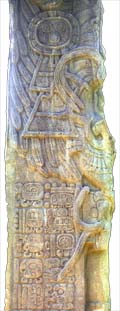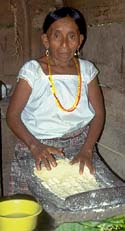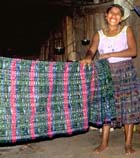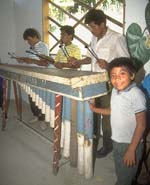
Mayan Traditions
Editor's Note: |  |
 Stellae at Quirigua | In our communities we have many beautiful traditions. Each school year has their favorites. For the Kek'chi people their traditions are very important because it gives them a sense of unity, and then they can remember about the lives and histories of their ancestors. Traditions also show to both the Kek'chi and to other peoples what is unique and special about the Kek'chi culture. It is possible to say that our traditions are a large part of the "glue" that help a tribe be united |
The Tamal
by the class of Armando Ic Rax, with help from Alicia Tiul
 One tradition that occurs on special occasions, and one that needs a lot of time to prepare is the making of the tamal. This is a food made from maize, the principal crop of our communities. The wet corn kernel is ground on the grinding stone until it is a paste. Then a tortilla is made. A condiment based on tomatoes is added to the tortilla to give it color and make it lighter (a Mayan version of baking soda). This condiment is called "tiu" by the Maya. Inside the uncooked tortilla we can place many ingredients, but the most common is pork or chicken. We also make a sauce from vegetables and pour it over the carne (meat). Then the parcel of food is placed in a large leaf called a "moshan" or, if these are not available, a banana leaf. It is then put in a cooking pot, placed on a fire and cooked for several hours. The normal preparation time to make tamales is six hours. After this it is ready and we can taste the delicious tamal.
One tradition that occurs on special occasions, and one that needs a lot of time to prepare is the making of the tamal. This is a food made from maize, the principal crop of our communities. The wet corn kernel is ground on the grinding stone until it is a paste. Then a tortilla is made. A condiment based on tomatoes is added to the tortilla to give it color and make it lighter (a Mayan version of baking soda). This condiment is called "tiu" by the Maya. Inside the uncooked tortilla we can place many ingredients, but the most common is pork or chicken. We also make a sauce from vegetables and pour it over the carne (meat). Then the parcel of food is placed in a large leaf called a "moshan" or, if these are not available, a banana leaf. It is then put in a cooking pot, placed on a fire and cooked for several hours. The normal preparation time to make tamales is six hours. After this it is ready and we can taste the delicious tamal.
The tamal is most commonly made at Christmas and for very special occasions such as the day of planting, marriages, celebrations in churches, etc. It is a very expensive to make tamales, especially because they are filled with meat, which is a real luxury for the villagers.
 Typical Costumes
Typical Costumes
by Grades 4, 5, 6 of Lo de en Medio School
The people of our village use a beautiful costume that is worn primarily by the women. For us it is a thing of pride to see the striking clothes that represent our culture. Generally the women use collars, they plait their hair and wear special blouses of various colors such as red, white, or yellow. They also wear the famous "Corte," which is a long piece of cloth wrapped around the women in the form of a skirt. The material is in large squares and is normally of many different colors. Each different Mayan tribe has different designs that help distinguish the different cultures and the corte is a Guatemalan tradition that is 100% indigenous.
El Baile del Venado
(The Dance of the Deer)
by Grades 3, 4, 5 of Lo de en Medio School
In our aldea there exists a tradition of many different dances. The most famous of these are the dance of the deer and the dance of the masks. What we like most to dance is the dance of the deer. We all participate in the ceremony, which lasts ten days, and we all drink a hot corn drink with sugar and eat tamales wrapped in a leaf. The neighboring aldeas come to watch because they love to see the traditions of our ancestors.
The dance of the deer is a tradition that we celebrate during Easter week and on the 15th of September (our Independence day). The community looks for 23 people to do this dance and we start little by little to pay for the costumes and to find three people to play the marimba. The dance is divided into 23 different roles starting with the old man and his wife. Then we have one dog, eight captains, eight Spaniards, two deer and two small monkeys. The monkeys pay their respects to all the participants and then start to dance around, begging money from the other dancers.
The musicians play the marimba and everyone drinks "guaro" (an alcoholic drink made from sugar cane) all night. Later, when the evening ends, everyone says their good-byes until they cry, and the dance is finished.
by Felipe Perez, 6th grade, Barra Lampara School
Guatemala Introduction | Guatemala Itinerary & Map
Guatemala Stories | Modern Mayan Lives
Other Guatemala Links
YBB Travel/Service Programs
Return to YBB Home Page | About YBB | Educational Presentation Programs
For information send email to: youthbeyond@earthlink.net

![]()
